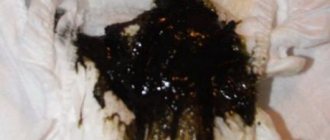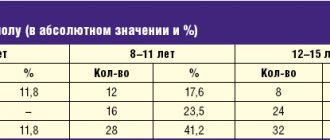When a newborn appears in the family, young parents immediately have many questions. One of the most popular and discussed topics at parenting conferences on the Internet is baby stool. New mothers are concerned about whether their baby’s bowel movements are normal, whether he has diarrhea (diarrhea) or, conversely, constipation, and whether it is necessary to take a stool test for dysbacteriosis?
Normal stool in children from 0 to one year is a relative concept. Firstly, its frequency and nature depend on the type of feeding (breastfeeding or bottle-feeding) and the availability of complementary foods. Secondly, as the child ages, the “norms” of stool change.
However, there are symptoms that are highly likely to indicate trouble in the baby’s body - if they appear, you should definitely consult a doctor :
- when breastfeeding, stool more than 7 times a day, and when feeding with formula - more than 4-5 times
- stool less than 1-2 times a day
- feces have a specific unpleasant odor or an admixture of mucus, greenery, blood
- watery or greasy stools
- When defecating, the child cries and kicks his legs
Intestinal infections
Intestinal infections are quite common in infants. Even the most careful and clean parents cannot always avoid the development of an intestinal infection in their baby. The fact is that the protective functions of the intestines (acidity of gastric juice, local immune factors) in infants are not yet fully formed, and some pathogens that are not dangerous for adults can cause serious disorders in an infant.
As a rule, the infection begins suddenly - with abdominal pain (the child cries, kicks his legs) and diarrhea (sometimes with inclusions of mucus, greens, blood and other impurities). Intestinal infections may be accompanied by a rise in temperature, but this does not always happen. If any of the described symptoms appear, be sure to call a doctor, and before he arrives, try to alleviate the child’s condition with the following measures:
- With loose stools, the child loses a lot of water and salts, and he may become dehydrated. To prevent this from happening, the baby must be given one of the saline solutions - for example, Oralite, Rehydron. The drug enterodez, in addition to salts, also contains activated carbon, which adsorbs toxins from the intestines. One of these drugs should be kept in your home medicine cabinet at all times. It is very important to completely replace the child with the volume of fluid that he loses through stool and vomiting (it is advisable to measure this volume). If the baby does not drink from a bottle, liquid can be given from a spoon or even from a pipette - small portions of liquid do not provoke vomiting as much as large ones. It is not advisable to give your child regular boiled water, since a lot of salts are lost with intestinal contents - if you give liquid without salts, this deficiency will worsen.
- In addition to fluid replenishment solutions, the child can be given adsorbents (smecta, polyphepan, enterosgel) - drugs that, like a sponge, absorb toxins contained in the intestines. But keep in mind that while these drugs absorb toxins, they do not destroy pathogenic bacteria. In large quantities they can lead to constipation.
- Should I feed my child in the midst of an intestinal infection? Yes, feed. But the amount of food per day should be reduced by 1/3-2/3 compared to normal (depending on the maximum amount of food that does not lead to vomiting). If the child is breastfed, then continue to feed him breast milk; in such situations, it is better to give artificial milk formulas to artificial babies. Feed more often, but in small portions. You can add 1/4 tablet of the enzyme preparation Mezim-Forte to each feeding. Here, perhaps, are all the measures that can be taken before the doctor arrives.
- Never give an infant antibiotics without a doctor's prescription: some of the antibiotics often used for intestinal infections in adults are contraindicated in newborns (for example, chloramphenicol). Great care should be taken when using drugs such as Imodium and other symptomatic drugs in infancy - be sure to consult your doctor.
How to protect a child from intestinal infections?
- First of all, you should pay attention to the dishes from which you feed your baby. It should be dry. Some mothers boil bottles for a long time, but then leave some of the moisture in them. Moisture promotes the growth of bacteria.
- Secondly, you should not often pour food from one dish to another - the less often you do this, the better. That is why modern breast pumps are immediately connected to a feeding bottle.
- Finally, avoid licking pacifiers, spoons, and other baby utensils. The germs in your mouth are not always safe for your baby (for example, Helicobacter, which causes peptic ulcers, or germs that cause tooth decay). Pathogenic bacteria are transmitted mainly from person to person, so it is better to simply rinse a pacifier that has fallen on the floor with water (at worst, not even wash it at all) than to lick it.
Lactase deficiency
If your child has frequent, watery, foamy stools with a sour odor, he or she may be lactose intolerant. Lactose is milk sugar, making up about 99% of all carbohydrates in any milk, including human milk. A special enzyme, lactase, is responsible for the breakdown of lactose. If for some reason the activity of this enzyme is reduced (so-called lactase deficiency ), excess undigested lactose leads to diarrhea.
The simplest and most accessible test for suspected lactose intolerance is to determine the amount of carbohydrates in the stool.
For proper treatment, it is necessary to find out the cause of intolerance, be sure to consult with a pediatric gastroenterologist and, possibly, an allergist. If a child has received breast milk, he is not deprived of this beneficial product. As a rule, it is recommended to express about 1/4-1/3 of the volume of one feeding and add lactase ( an enzyme that breaks down lactose) to the expressed milk. At the beginning of feeding, the baby should be given expressed milk with lactase , and then supplemented from the breast. The dosage of the enzyme is selected by the doctor individually.
If the child is on artificial or mixed feeding, then the adapted milk formula is either replaced with a low-lactose or lactose-free formula (it is also better to consult a doctor about the selection of a medicinal formula), or a lactase is added to the regular milk formula and incubated for some time before feeding.
As children grow older, the activity of the lactase increases and the symptoms of lactose intolerance completely disappear.
What will a baby's stool tell you?
Young parents look at the contents of a baby's diaper with interest and trepidation... is this a familiar sight? The stool often causes anxiety in the mother and can really tell about the health and unhealthiness of the baby - you just need to be able to “read between the lines,” that is, understand the signs of the body.
Let's get to know the norm
While the baby lives and develops in the mother's womb, meconium accumulates in his intestines. It is a homogeneous tar-like mass of dark olive, almost black color, practically odorless. It consists of desquamated cells of the intestinal mucosa, amniotic fluid swallowed by the baby, etc. Normally, meconium begins to be released from the baby’s intestines after birth and therefore is also called original feces (sometimes meconium is released in utero: in case of unfavorable course of labor or at the very end of pregnancy, oxygen starvation the fetus causes premature bowel movement, in which case meconium enters the amniotic fluid and turns it green). The baby's stool is usually represented by meconium in the first two or three days, that is, until the mother produces a large amount of milk. Sometimes it happens that after the bulk of the meconium has passed, say, during the first 24 hours, until the mother has milk, the baby may not have any stools at all. This is due to the fact that the colostrum, which the baby eats in the first few days, is absorbed by the body almost completely, so that there are no toxins left in the intestines - therefore, there is simply nothing to be excreted.
After the mother has established active lactation, the baby’s stool gradually becomes mature, usually passing through a transitional stage. Transitional stool is a stool that combines the features of original stool and mature stool; it has a pasty consistency, a yellow-green color and a sour odor. Mature stool is distinguished by a pure yellow color, a homogeneous mushy consistency (it is often compared to thin sour cream), and the smell of sour milk. Its frequency is higher, the younger the child: in the first weeks after birth, bowel movements can occur almost after every feeding, that is, per day it can reach 5-8, and sometimes even 10 times. Gradually, stools are reduced to approximately 1-3 times a day, but there is a rare variant of the norm when mother’s milk is so completely absorbed by the baby’s body that almost no undigested residue accumulates in his intestines. In this case, bowel movements can occur once every few days, sometimes even once a week. This is due to the fact that only sufficient filling of the large intestine with waste (undigested food debris) is a signal for contractions of the intestinal walls, leading to emptying. That is why the intestines must first “accumulate” the remains in order to then throw them out. As a rule, this feature of the absorption of mother's milk becomes obvious in babies no earlier than 1.5-3 months. Let's make a reservation: the frequency of stool once every few days can be considered normal only if three conditions are met: with completely natural feeding (that is, the baby does not receive anything other than mother's milk), age of at least 1.5 months and the absence of any signs of ill health - pain and bloating in the abdomen, discomfort and difficulty during bowel movements - that is, when the baby eats well, gains weight correctly and nothing bothers him.
Stool during formula or mixed feeding may be no different from normal mature stool during breastfeeding, or it may have a more “adult”, putrid smell, a thicker consistency and a darker, brownish color. Bowel movements during mixed or artificial feeding should occur at least once a day; anything else is considered constipation.
Now that we have become familiar with the “ideal” process, it is necessary to become familiar with possible deviations from this.
Greens in the chair
It often happens that the “correct” type of stool is not established for a long time, and even against the background of active lactation in the mother, the stool for a long time retains the features of a transitional one, that is, it has a clear greenish tint, sometimes mucus is also found in it. There are several reasons for this:
- Malnutrition (so-called “hungry” stool). This often occurs due to a lack of milk from the mother. Factors that make it more difficult for a baby to “extract” milk from the breast can also be flat and inverted nipples and tight breasts, especially after the first birth.
- The predominance of fruits and vegetables in the diet of a nursing woman in comparison with other products, as well as the mother’s consumption of products containing synthetic additives: sausages, smoked meats, all types of canned food, industrial juices, dairy products with fruit and other aromatic fillers.
- Inflammation of the intestinal mucosa in a baby. A very common reason for this is fetal hypoxia (oxygen starvation) experienced during pregnancy and/or childbirth. This pathological condition affects many tissues in the body, including the intestinal mucosa, which then takes quite a long time to recover. In addition, inflammation of the intestinal mucosa can be caused by the influence of synthetic substances - flavors, dyes and preservatives and any artificial compounds present in the mother's diet that penetrate into breast milk and directly affect the intestinal mucosa. Finally, a very common cause of intestinal inflammation is a disruption of the normal intestinal microflora - in other words, intestinal dysbiosis (or dysbiosis), when representatives of the normal microflora become small, they are partially replaced by so-called opportunistic microbes, that is, pathogens that, under unfavorable conditions, can cause inflammation in the intestines. In this case, the mucous membrane suffers as a result of the influence of pathogenic microorganisms and their metabolic products. The risk of developing dysbiosis increases significantly if the mother and/or baby are prescribed antibacterial drugs.
What to do? If there is greenery in the stool, the first thing to do is to rule out malnutrition in the baby. Of course, in addition to stool disorders, other symptoms will be noted: the baby may show dissatisfaction at the breast, if milk is poorly released from the nipple, he does not fall asleep after feeding and / or never stands more than 1-1.5 hours between feedings, he has the rate of weight gain and growth is reduced. With severe malnutrition, the number of urinations may decrease in a child (normally it is at least 6-8 per day), urine may be more concentrated (normally it is almost colorless and has only a slight odor). Next, you should act according to the situation: if lactation is insufficient - switch to feeding “on demand”, or “at the first cry”, put the baby to the breast more often, allow him to stay at the breast as much as he wants, give both breasts at one feeding, be sure breastfeed during the night, take medications that stimulate lactation. If the cause of malnutrition lies in the irregular shape of the nipples, it may be worth using special nipple shields during feeding. In any case, if you suspect your baby is malnourished, it is better to contact your pediatrician, as well as a lactation consultant.
Next, you should carefully check your mother’s diet. All products containing synthetic additives are subject to unconditional exclusion. We should not forget that often the cause of intestinal inflammation in a baby can be synthetic vitamin preparations taken by the mother (including for pregnant and lactating women), so it is necessary to exclude their intake. You should also make sure that the amount of fruits and vegetables in the diet does not prevail over other products (these “gifts of the earth” contain a large amount of acids, an excess of which in breast milk can cause inflammation of the mucous membrane in the baby’s intestines).
Now that we have created all possible prerequisites for proper nutrition of the baby, we should be guided by his well-being. If the baby is gaining good height and weight, he is not bothered by abdominal pain and allergic reactions, he is generally healthy and cheerful, and is interested in the world around him according to his age, then the only symptom - the green color of the stool - can be ignored: most likely he will reflect the consequences of hypoxia or the presence of intestinal dysbiosis in the baby. In the human body, especially one that has recently been born, everything proceeds according to its own laws and at an individual speed. Colonization of the intestines with the “right” microbes is not a process of one day or even one week, so even in completely healthy children, transitional stool can persist for up to a month or even more. If this does not interfere with the baby’s normal development, you can not interfere with this process. Still, no drug has yet been created for dysbiosis better than breast milk. The only thing that doesn’t hurt to do if there are lingering signs of dysbacteriosis is to submit the mother’s milk for culture to make sure that it does not contain pathogenic microbes (if any are detected, their sensitivity to antibacterial drugs must be determined, then the mother is treated with the most effective antibiotics for this case - During this period, breastfeeding is usually stopped).
If not everything is fine in the baby’s well-being (for example, he is tormented by intestinal colic, or skin allergic reactions are noted, or he is not gaining enough weight and height), then you should undergo some tests - a coprogram and a stool flora analysis (or, as they say , for dysbacteriosis). The coprogram will show how digestion processes are progressing in the intestines and can confirm the presence of inflammation of the mucous membrane (this will be indicated by an increase in the number of leukocytes in the stool, a sharply acidic reaction, and the presence of hidden blood). In a flora analysis, the main attention should be paid to the presence and/or quantity of pathogenic microorganisms - those that should not normally be found in the intestines or the number of which should not exceed certain limits. The number of “friendly” microbes may be completely indicative if the stool is analyzed later than two hours after collection. Since this is exactly what happens in the vast majority of cases, you don’t need to pay much attention to the number of normal microbes in this analysis. The detection of pathogenic (disease-causing) microbes (provided that the mother’s milk has been analyzed and the mother has been treated, if necessary) is the reason for prescribing special medications to the baby. As a rule, treatment is carried out with phages - special viruses that destroy a certain type of pathogenic microbes and do not affect the flora as a whole. In some cases, antibacterial drugs may be prescribed, taking into account the sensitivity of pathogenic bacteria to them. Treatment is completed with drugs that help restore normal microflora.
White lumps in the stool Sometimes you can see white lumps in the baby’s stool, as if someone had mixed coarse cottage cheese into it. If this symptom is observed against the background of the normal physical development of the child (he is gaining weight well and growing), then it is evidence of some overeating: more nutrients enter the body than it needs to satisfy real needs (when the breast is offered not only to satisfy hunger , but also any reassurance). There is absolutely nothing wrong with this, since the baby’s body is perfectly adapted to such “overkill”: it simply throws out the excess in the form of such undigested white lumps. Nowadays, when the policy of feeding “at first cry” has been taken, most healthy children at least from time to time have this feature of their stool. If this symptom is accompanied by a lack of weight or height, especially if this lag worsens, most likely there is an enzymatic deficiency of the digestive glands, which does not allow the incoming nutrients to be properly digested. In this case, a pediatrician or gastroenterologist may prescribe enzyme replacement therapy.
Lactase deficiency
Quite often, parents may encounter that the baby’s stool is liquefied, watery, sometimes foams, has a sharper sour smell, and in some cases a changed color - mustard or greenish. On a cotton diaper, such feces leave a water zone around it. Often, stool is passed in small portions even when gas is passed. The acidic reaction of feces often causes persistent diaper rash. This picture is observed when the digestion of lactose, milk sugar, is impaired, when for some reason the amount of lactose entering the intestines with mother’s milk exceeds the amount of the lactase enzyme necessary for its digestion. This can be either due to an excess of lactose in milk (hereditary predisposition of the mother, excess of fresh milk and dairy products in her diet), or due to reduced production of lactase by the baby’s digestive glands. Undigested carbohydrates “pull” a large amount of water into the intestinal lumen, which is why stool has a liquefied, watery character.
Often, lactase deficiency is accompanied by intestinal dysbiosis: the acidic reaction of intestinal contents prevents the colonization of the intestines with the correct flora, and the lack of the required amount of beneficial microorganisms, in turn, reduces the ability to digest carbohydrates. If this does not interfere with the baby’s development (as we have already said, its signs are normal growth and weight gain, the absence of intestinal colic and persistent diaper rash), this condition can be left without treatment. In the vast majority of cases, lactase deficiency is a transient problem and disappears without a trace with age (by about 9-12 months, the activity of the digestive glands increases so much that the baby’s body can easily cope not only with fermented milk products, but also with fresh milk). Severe and lifelong disorders of lactase production are almost always genetically determined: this type of hereditary disease should be considered if close relatives in the family suffer from lactase deficiency in adulthood.
To confirm the diagnosis, in addition to scatological examination, a stool test for carbohydrates is performed. If lactase deficiency is confirmed, the mother should first adjust her diet: exclude fresh milk; if this step is ineffective, significantly reduce the amount of fermented milk products (the exception is cheese, which has virtually no milk sugar). If all of these measures fail, your doctor may prescribe lactase replacement therapy.
Constipation
Constipation is considered to be the absence of independent stool for more than a day (of course, except in cases of complete digestion of milk), as well as cases when bowel movements are difficult and accompanied by significant discomfort.
Constipation is quite rare during breastfeeding, and there are two main reasons for it: poor nutrition of the mother and impaired intestinal motility, including spasm of the anal sphincter.
Malnutrition of the mother is expressed by a tendency towards foods rich in proteins and easily digestible carbohydrates, and a lack of dietary fiber. Therefore, if the baby develops constipation, the mother should first normalize her diet: give preference to cereals (especially buckwheat, brown rice, oatmeal), whole grain bread, and include boiled vegetables in the diet. Some products (peaches, apricots, prunes, dried apricots, figs, boiled beets, fresh kefir) have pronounced laxative properties. In many cases, they will normalize not only your own stool, but also the baby’s stool.
If such measures do not lead to anything, most likely there is a violation of intestinal motility (hypotension or, on the contrary, spasm) and/or spasm of the anal sphincter. When the sphincter spasms, the passage of gases from the intestines is also difficult, so constipation is often accompanied by severe intestinal colic. Unfortunately, it is almost impossible to combat these conditions with home methods, since they are associated with a violation of the nervous regulation of smooth muscle tone and are consequences of birth trauma or an unfavorable course of pregnancy. If they are accompanied by other symptoms that force you to consult a neurologist (excitability or, conversely, lethargy of the baby, sleep disturbances, weather dependence, muscle tone disorders, etc.), then the treatment prescribed by him for problems with the central nervous system often helps to improve the situation with constipation. If, in the absence of stool, the baby is bothered by pain and/or bloating in the abdomen, you can try installing a gas outlet tube, which will allow you to gently stimulate the anus. With artificial feeding, constipation, unfortunately, is much more common, since the digestion of infant formula is a great difficulty for the baby's digestive system. In many cases, the situation can be normalized by replacing half of the baby’s daily diet with fermented milk formula (sour milk formula can be gradually introduced after 3 weeks of life). After 4-6 months of life, you can introduce decoction and puree of prunes into your baby’s diet, which help cope with constipation in most cases.
Lactase deficiency due to allergic inflammation in the intestines
In cases where a child begins to receive foreign protein too early (most often these are cow's milk or soy proteins contained in formula feeding), allergic inflammation often develops in the intestines. As a result, lactase production is disrupted.
Allergic inflammation in the intestines is not always accompanied by changes in the skin, and outwardly the child may not have any signs of allergy. In addition to impaired digestion of lactose, these children have impaired absorption of many other substances in the intestine. Therefore, it is recommended to conduct an allergy examination in a bottle-fed child with prolonged diarrhea.
Deficiency of various enzymes - sucrase, isomaltase, etc.
Each enzyme is responsible for the breakdown of “its” food component (sucrose, fructose, etc.), and is necessary for normal digestion. Symptoms of enzyme deficiency occur when certain foods are consumed and are similar to lactase deficiency. However, this type of disorder is much less common.
The first symptoms of sucrose intolerance appear when regular sugar is included in children's diets (many try to sweeten complementary foods); fructose intolerance - when including honey and juices in the child’s diet, etc. Before visiting your doctor, try to remember if diarrhea has developed after introducing new foods to your baby or, if you are exclusively breastfeeding, after any changes in your diet.
Constipation is a common and pressing pediatric problem faced by parents around the world. In 90 - 95% of children with constipation, no organic cause has been found. Only 60% of children with constipation showed a positive effect when treated with laxatives. Even after a year of treatment, constipation disappeared in only 53% of children, and 52% of them continued to suffer from constipation over the next 5 years. Moreover, approximately 30% of children after puberty continue to struggle with symptoms of constipation, such as irregular and painful bowel movements or, conversely, involuntary passage of stool. Normally, depending on the age of the child, the periods between independent acts of defecation may vary.
Prevention of yellow diarrhea
In a newborn, diarrhea is easier to prevent than to treat. To this end, you must adhere to the following rules:
- a nursing mother should be on a hypoallergenic diet,
- follow the rules for introducing complementary foods (at 6 months - vegetable puree, at 8-9 months - low-fat pureed
- meat, at 10-12 months. - steamed fish cutlets),
- keep baby care products clean,
- observe food expiration dates,
- carefully thermally process food products,
- Avoid feeding your baby cow's milk.
Liquid yellow stool in a newborn is normal. If diarrhea occurs or foamy, watery or greenish stool appears, you should contact your pediatrician.
Age norms
A breastfed newborn baby can have bowel movements as many times as he is fed. If a child has stool 1-2 times a day or less during the first 3 months of life, you should consult a doctor. For bottle-fed children under one year of age, constipation is considered to be the absence of independent bowel movements during the day.
A common cause of constipation in breastfed infants is disturbances in feeding and nutrient absorption. If there is quantitative underfeeding or good absorption of the mother's breast milk, the volume of feces in the child is not sufficient to arouse the urge to defecate. In such cases, retention of stool for 2–3 days is not considered true constipation. Constipation in infants who are breastfed and complementary foods is caused by a lack of foods containing plant fiber. Excess fat in food aggravates constipation, promoting the formation of soap in the intestines and thereby further hardening the stool.
In addition to reducing the frequency of bowel movements with constipation, children may experience a decrease in appetite and abdominal pain. With chronic constipation, the volume of stool increases.
Green stool in a newborn
Why a baby has green stools cannot be answered with certainty. Unnaturally green stools against the background of increased gas formation and a body rash can signal disturbances in the intestinal microflora and dysbacteriosis. Green, foamy stool in infants is often associated with lactose intolerance. Stools containing staphylococci and streptococci will also be green and foamy. When an infection occurs, the baby usually vomits, has a fever, and suffers from intestinal colic, and the first aid in this case will be an urgent medical examination. Medicinal mixtures and iron supplements also give the stool a greenish tint.
Causes and types
Constipation in a child may be one of the manifestations of diseases not directly related to the pathology of the gastrointestinal tract (such as rickets, hypothyroidism). However, in the vast majority of cases, constipation is caused by problems with the intestines themselves.
During the process of digestion, the intestinal walls contract in waves, pushing the contents towards the outlet - this phenomenon is called peristalsis or intestinal motility.
There are two main options for intestinal motility disorders:
- If the child’s stool is very rare, accompanied by bloating, and when the intestines empty the volume of stool is large (as in an adult), we can assume that he has so-called atonic constipation . Constipation associated with insufficient contractile activity of the intestines is called atonic. In this case, the child may not have the urge to defecate for a long time. Compulsory measures (long-term potty training) usually only aggravate the situation and reinforce the child’s negative attitude towards what is happening.
- Thick stools consisting of hard, smooth pellets (the so-called “sheep feces”), abdominal pain, and sometimes pain during defecation usually indicate spastic constipation . Spastic constipation in children occurs due to spasms (increased contractile activity) of the intestines.
In some cases, stool is released in the form of a ribbon or a thin stream. In such a situation, the child should be consulted with a surgeon to exclude organic pathology of the rectum (narrowing, neoplasm).
Folk remedies for diarrhea in infants
It must be remembered that not all folk remedies are equally effective for young children. They are mainly intended for adults, and they are absolutely not suitable for children who are not able to cope with most of the options offered. If we consider folk remedies for diarrhea in infants, we can highlight:
- rice water;
- jelly with a little added sugar;
- weak solution of manganese.
It is impossible to conduct more experiments on the child’s body, since other means are not so effective and are even slightly dangerous for the child’s health.











